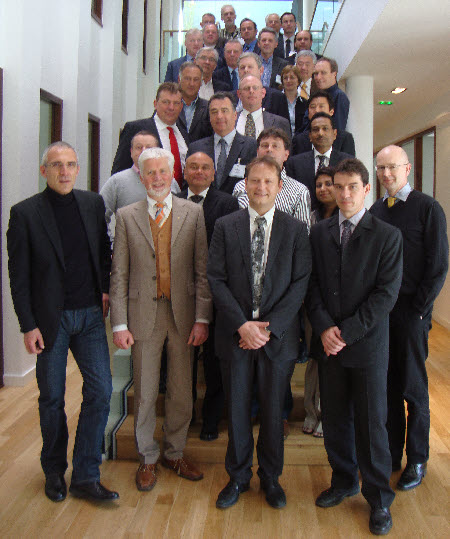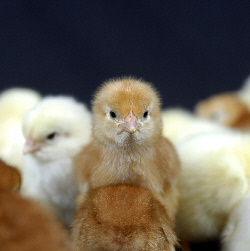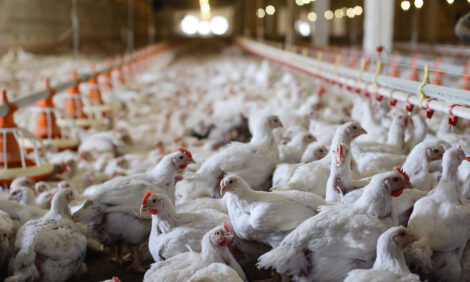



New Layer Genetics Company Matures with Ambitions
Just a few years after entering the layer genetics market, Novogen says it has already come of age and is looking to the future, writes senior editor, Jackie Linden.At a meeting recently in Nantes, France, near to the company’s headquarters, senior managers from Novogen and its parent, Groupe Grimaud, outlined the short history of the company and its future ambitions.
Novogen: Part of Groupe Grimaud
Groupe Grimaud is a solid family group, developing know-how and products in the life science field, applied to animal genetic selection and biopharmacy, explained its President, Frédéric Grimaud.
Groupe Grimaud started in 1968, when the Grimaud brothers started a duck breeding programme. This rapidly developed into what is now the second largest multi-species breeding company in the world, he said, with a turnover of close to €230 million and 1,600 employees of 30 nationalities worldwide.
Mr Grimaud explained that the Groupe Grimaud business model is characterised by a proactive development following three axes:
- organic growth and consolidation in multi-species breeding
- alliances and acquisitions, and
- innovative projects.
In the years to come, he continued, Groupe Grimaud wants to develop further its worldwide leadership position in animal genetics and in biopharmacy serving human and animal health.
With its ‘Natural Concept’, Groupe Grimaud practices a unique vision on sustainable breeding and production of animal protein, he said.
With ‘Customers first!’ and ‘Our team’ among its fundamental values, Groupe Grimaud puts people first, which in every respect is a winning business strategy, added Mr Grimaud.

front row, left to right: Frédéric Grimaud; Jürgen Reimers (consultant); Mickaël Le Helloco and Thierry Burlot
Novogen: Genetics to Meet Different Market Demands

Mickaël Le Helloco, Managing Director of Novogen, stressed that, as a company of Groupe Grimaud, a solid family group, Novogen is contributing to the development of know-how and products in the life science field, applied to animal genetic selection and biopharmacy. Established in July 2008, Novogen is the group’s layer breeding company, focussing on high quality products, productivity – both longevity and persistency – efficiency and suitability for various production systems.
With its NOVOgen Brown, Tinted and White layers, the company has successfully introduced a complete range of products for all markets, said Mr Le Helloco. Although Novogen is a newcomer in the market, he stressed that its products have a proven to express a high standard of egg quality (shell colour, shell strength and internal quality), a high and efficient production potential and a good ability to adapt to various production systems.
Novogen’s dedicated, professional and passionate team enables a global R&D, production and sales approach, he continued. Novogen has its own R&D facilities in Europe and North America and shares Groupe Grimaud’s know–how and experience in animal genetics.
Novogen has already delivered its products to more than 40 countries around the world, according to Mr Le Helloco. Part of the success of Novogen is due to the fact that Novogen has a strong and continued focus on, and understanding, of customer demands. Over the last few years, the company has been able to realise a substantial share of a market that was dominated by just a few players, thus giving support to their credo that Novogen is more than just an alternative; it offers a real economical solution.
Mr Le Helloco explained that, in a world where the human population is growing at a rate of 220,000 people every day, animal protein consumption and health care are strategically growing businesses. Eggs are a relatively cheap protein source with a high nutritional value, which has allowed the global egg market – based on local production for local consumption – grow at a steady pace of two to three per cent per year. Global egg output is now at a level of some 63.5 million metric tons per year, he said, and about half of this production is in Asia.
From a global perspective, brown eggs are the most in demand with a market share of some 50 per cent, said Mr Le Helloco, followed by white eggs (about 46 per cent) and tinted eggs account for the remaining four per cent, mostly for China and Japan.
In terms of production system trends, Mr Le Helloco singled out a significant increase in alternative housing, especially in the EU, where Germany now has the highest level of free–range, barn and organic eggs.
Research Focus into Meeting Market Needs
| * "The most important objective for R&D is to select for better eggs in different production systems." |
|
Thierry Burlot
|
Novogen’s genetics are developed to meet different market needs, said R&D director, Thierry Burlot. The company’ dedicated and professional team translates market demand into prioritised product specifications. He elaborated the four main selection criteria – and thus continuous attention points – for R&D, as high standards of egg quality, productivity (longevity and persistency), efficiency and ability to produce in various production systems.
The starting point for selection, continued Mr Burlot, is the understanding that a bird’s adaptation to different circumstances is based on the ’Genotype × Environment Interaction’. Birds have to be selected under the particular conditions in which we want them to perform best. He explained that it is not only the genetic potential but also the adaptation of a bird to a specific environment that contribute to the overall performance. The most important objective for R&D, Mr Burlot stressed, is to select for better eggs in different production systems.
Novogen has its own R&D facilities at three locations in France. In these new facilities, the highest biosecurity, health and sanitary standards are used and the accommodation is equipped with the latest technology in environmental control. Accurate data collection and housing conditions that represent field conditions assure the best basis for a complete, original and field–orientated selection programme, said Mr Burlot.
He continued that his well-trained team uses the latest technology in terms of IT–platform, Quantitative Selection (BLUP) and Marker–Assisted Selection. In addition, Novogen R&D is in continuous and close contact with Groupe Grimaud experts on animal selection and various external research centres to enable them to validate findings and further improve the performance of birds as well as to be at the forefront of state–of–the–art research & development, while also ‘keeping both feet on the ground’, he added.
Finally, Mr Burlot said that years of trials and on–going genetic selection have made it possible to introduce the NOVOgen Brown, Tinted and White in 2008, which, he said, have proven to be the best possible answer for high quality products, productivity, efficiency and ability to produce in various production systems.
And every new generation will show an on-going improvement, leading Novogen and its customers step by step to the top, he concluded.
Dutch Hatchery Joins Novogen's Customer Base
Based in the centre of the Netherlands, Verbeek Hatchery is one of Europe’ biggest layer hatcheries, according to the company’s Business Unit Manager, Herman Brus.
He explained that in the second half of this year, Verbeek will introduce two new layer breeds: NOVOgen White and NOVOgen Brown, while continuing its long–term independent distributorship of Lohmann and H&N breeds.
Explaining the decision, Mr Brus said that while Verbeek has been successful in expanding its volume with these layers from the two companies in the past five years, it saw a need for more diversity in the worldwide layer gene pool.
He elaborated, saying that Verbeek values the innovation it sees at Novogen and appreciates the opportunity to influence breeding targets. Also, his company needed to grow and expand outside the Netherlands, while maintaining Verbeek’ reputation as a specialist hatchery, rearing and sales company for layer birds.
Verbeek opened a new state–of–the art layer hatchery at Zeewolde in one of the Dutch Polders in March 2011. With a capacity of 30 million female layer chicks, the company says it is Europe’s largest layer hatchery. Standards of hygiene and climate control are among the highest in the sector and the latest technology in incubation, hatchery automation and chick handling have been installed.
With this multi–million Euro investment, independent hatchery, Verbeek Hatchery Holland says it has demonstrated its commitment to be a top chick supplier, not only in the Netherlands and Europe but also in the Middle East and Africa.
March 2012









